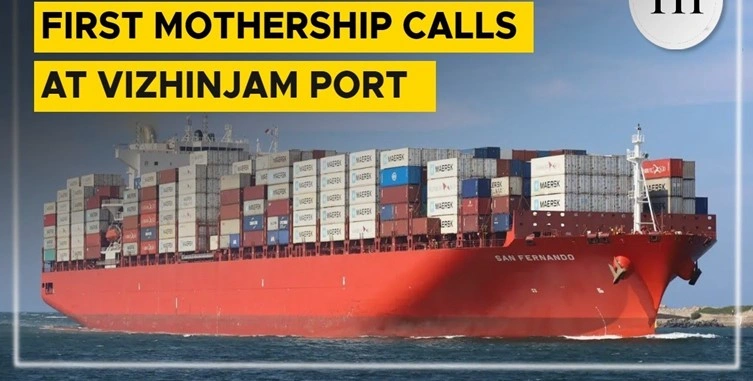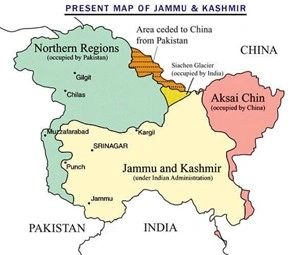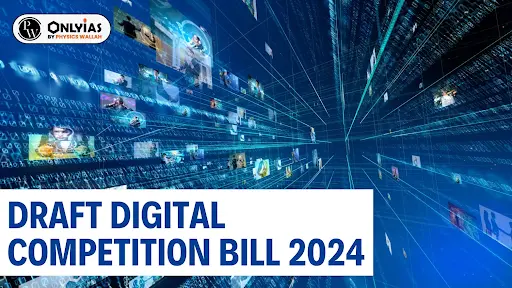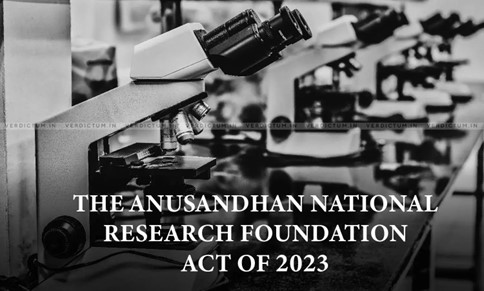Saturday, 13th July 2024
ED's Power to Arrest
Why in the News?
- Recently, the Supreme Court has granted interim bail to Delhi Chief Minister Arvind Kejriwal.
- A two-judge bench of SC referred some questions on the ED’s power to arrest under Section 19 of the stringent Prevention of Money Laundering Act (PMLA), 2002 to a larger bench.
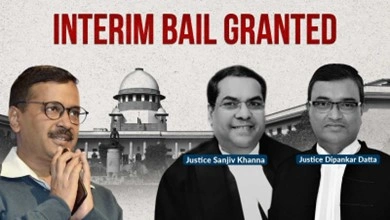
Section 19 of the PMLA:
- About: Section 19 of the PMLA grants the ED Director the authority to arrest individuals. According to Section 19(1):
- If the Director "has on the basis of material in his possession, reason to believe (that reason for such belief to be recorded in writing) that any person has been guilty of an offence punishable under this Act, he may arrest such person and shall, as soon as may be, inform him of the grounds for such arrest."
Power of Arrest under this Section:
- An ED officer must have "reason to believe," based on material in their possession, that the accused is guilty of the offence.
- This belief must be recorded and communicated to the accused at the time of arrest.
- The provision states that the arrest has to be on the basis of material evidence in possession of the ED.
- However, the ED sometimes emphasises the phrase "reason to believe" in Section 19, contending that the Director's belief, which is subjective and can evolve during the investigation, is sufficient for an arrest without necessarily delving into the materials.
Stricter than Ordinary Criminal Law:
- This standard under Section 19 of PMLA is stricter than ordinary criminal law, where police can arrest based on reasonable suspicion under Section 41 of the CrPC.
- The PMLA also imposes a reverse burden of proof, requiring the accused to prove their innocence, unlike in ordinary law where the prosecution must prove guilt.
- For bail under the PMLA, the court must find prima facie that the accused is not guilty.
Legal Validity:
- In the 2022 Vijay Madanlal Chaudhary ruling, the Supreme Court upheld the constitutional validity of Section 19 of the PMLA.
- The court did not address the necessity of arrest or the standard of evidence required (proportionality aspects), but affirmed that the extensive power to arrest is not unconstitutional.
- The SC endorsed a key argument by the ED that only high-ranking officials, after recording reasons in writing, can authorise an arrest.
- The court noted that granting this power to high-ranking officials, combined with the requirement to provide reasons in writing, ensures reasonableness and minimises the risk of arbitrariness.
Questions Raised Over ED’s Power to Arrest under Section 19 of PMLA:
- Observations by the SC:
- The Supreme Court clarified the interpretation of "reasons to believe" under Section 19 of the PMLA.
- The court held that the ED must meet a higher standard, requiring reasons that are almost equivalent to "evidence admissible in court" to establish guilt, rather than just a subjective finding by the ED.
- The SC emphasised that the material in possession must lead the designated officer to form an opinion of guilt based on admissible evidence, not on inadmissible evidence.
- The court highlighted that arrests must not be arbitrary and must be based on valid "reasons to believe" that adhere to legal parameters.
- The Supreme Court emphasised that the clear language of Section 19(1) must be upheld to ensure stringent safeguards against pre-trial arrests during ongoing investigations.
- The court distinguished between the power to arrest and the process of framing charges and conducting a trial.
- It noted that an individual can face charges and undergo trial while on bail, underscoring that arrest should not be equated with the commencement of trial proceedings.
- Need to Scrutinise the ED's Use of Its Arrest Powers:
- The Supreme Court did not rule on the legality of Kejriwal's arrest but found sufficient grounds to scrutinise the ED's use of its arrest powers.
- The court stated that this issue needs "in-depth consideration" by a larger Bench.
- Given that the Delhi CM Kejriwal had been incarcerated for over 90 days, the court ordered his release on bail until the larger Bench addresses the matter.
Analysis of the Remarks Made by the Apex Court:
- Necessity for Clear Guidelines to Prevent Potential Misuse of Authority:
- The ruling, while deferring the key question of when an arrest is legally necessitated to a larger Bench, raises significant concerns about how the ED exercises its extensive powers under the PMLA.
- This decision highlights the need for a thorough examination of the ED's arrest procedures and underscores the necessity for clear guidelines to prevent potential misuse of authority.
- Raised the Bar for Arrest by the ED under the PMLA:
- Arrests must be based on valid 'reasons to believe,' meeting the parameters prescribed by the law.
- This ruling emphasises that arrest cannot be made arbitrarily and on the whims and fancies of the authorities.
|
UPSC Civil Services Examination, Previous Year Questions (PYQs) Mains Q:1 Discuss how emerging technologies and globalisation contribute to money laundering. Elaborate measures to tackle the problem of money laundering both at national and international levels. (2021) |
Source: TH
Push for Hybrid Electric Vehicles
Why in the news ?
- Recently, the Uttar Pradesh state government announced the waiver of registration fees for strong hybrid and plug-in hybrid electric vehicles (EVs).
- This initiative aims to encourage adoption of cleaner alternatives to petrol and diesel vehicles, aligning Uttar Pradesh with Tamil Nadu and Chandigarh, which also provide incentives for similar vehicles.
 What is a Hybrid Electric Vehicle (HEV)?
What is a Hybrid Electric Vehicle (HEV)?
- About Electric Vehicles (EVs):
- Definition: An Electric Vehicle (EV) is powered by an electric motor that draws electricity from a battery and can be charged from an external source.
Types of Electric Vehicles (EVs):
- Battery Electric Vehicle (BEV): Fully powered by electricity, offering higher efficiency compared to hybrids.
- Fuel Cell Electric Vehicle (FCEV): Uses hydrogen to produce electric energy through a fuel cell.
- Hybrid Electric Vehicle (HEV):
- Description: Also known as Strong Hybrid EV, HEVs utilise both an internal combustion engine (typically petrol) and a battery-powered motor.
- Functionality: The petrol engine drives the vehicle and charges the battery when needed, though not as efficient as fully electric or plug-in hybrids.
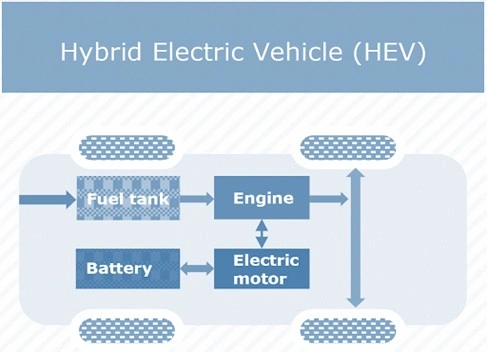
● Plug-in Hybrid Electric Vehicle (PHEV)
- Definition: Plug-in Hybrid Electric Vehicles (PHEVs) use both an internal combustion engine and a battery that can be charged from an external source via a plug.
- Charging: The vehicle's battery is solely charged using external electricity, not by the engine.
- Efficiency: PHEVs are more efficient than Hybrid Electric Vehicles (HEVs) but less efficient than Battery Electric Vehicles (BEVs).
- Modes of Operation:
- Hybrid Mode: Utilises both electricity from the battery and petrol/diesel from the internal combustion engine.
- All-electric Mode: Relies solely on the motor and battery for the vehicle's propulsion, offering zero-emission driving for a limited range.
Significance of Hybrid Electric Vehicles (HEVs):
- Practicality in the Medium Term (5-10 years):
- HEVs do not require extensive external charging infrastructure, making them a practical and viable option as India transitions towards full electrification of its vehicle fleet over the next 5-10 years.
- Cost of Ownership Perspective:
- Hybrids are cost-effective due to government incentives such as waivers on registration and RTO fees.
- For instance, the Uttar Pradesh government's 100% waiver on registration fees for strong hybrids could save buyers up to Rs 3.5 lakh.
- Hybrid cars offer better fuel economy compared to conventional fuel vehicles, resulting in long-term cost savings for drivers.
- Critical for Decarbonisation Drive:
- Environmental Impact: HEVs contribute to India's decarbonisation efforts by emitting lower total (well-to-wheel, or WTW) carbon emissions compared to both electric vehicles (EVs) and traditional internal combustion engine (ICE) vehicles of similar size.
- Emission Comparison:
- HEVs emit approximately 133 g/km of CO2.
- EVs emit around 158 g/km of CO2, making HEVs 16% less polluting than EVs.
- In contrast, petrol vehicles emit about 176 g/km of CO2, and diesel vehicles emit about 201 g/km of CO2, highlighting the environmental advantage of HEVs in reducing emissions.
Challenges in Adoption of Electric Vehicles (EVs) in India:
- Higher Cost:
- High upfront cost compared to ICE vehicles is a primary barrier due to expensive batteries, deterring affordability in India's price-sensitive market.
- Lack of Clean Energy:
- India's reliance on coal for electricity generation undermines EV adoption's carbon emission reduction goals.
- Supply Chain Issues:
- Global supply chain challenges for lithium-ion batteries, with over 90% of lithium production centralised in a few countries, necessitate heavy imports for India's growing EV battery demand.
- Underdeveloped Charging Infrastructure:
- India's inadequate EV charging network, with only 12,146 public stations mainly in urban areas, falls far behind global standards, hindering widespread EV adoption.
- Suboptimal Battery Technology:
- Current EV batteries face limitations in capacity, voltage, and driving range, exacerbated by aerodynamic drag and vehicle weight, restricting long-distance travel without frequent recharging.
- Persistent Resistance to Change:
- Despite economic and environmental benefits, Indian consumers, particularly in rural areas, show reluctance towards EV adoption due to low awareness and apprehension about new technologies.
Way Forward for Electric Vehicle Adoption in India:
- Addressing Cost Concerns:
- Government Initiatives: Provide targeted demand incentives and subsidies, particularly for middle-income and budget segments.
- Infrastructure Development: Establish a network of battery swapping stations to reduce charging time and alleviate range anxiety.
- Focus on Two-Wheelers: Promote adoption of electric two-wheelers to expand the EV user base.
- Enhancing Charging Infrastructure:
- Priority Areas: Install fast-charging stations along major highways and in urban centres to support long-distance travel and urban EV usage.
- Integration of Renewables: Utilise solar and wind power to ensure sustainable and emission-free charging solutions.
- Boosting Battery Technology and Supply Chain:
- Incentivizing Domestic Manufacturing: Encourage setting up domestic lithium-ion cell manufacturing facilities to reduce import dependency.
- Battery Recycling: Implement efficient battery recycling programs to address environmental concerns and minimise reliance on virgin raw materials.
- Promoting Consumer Awareness and Education:
- Public Awareness Campaigns: Conduct targeted campaigns to dispel myths and highlight the economic and environmental benefits of EVs.
- Rural Outreach: Focus on rural areas with outreach programs to encourage adoption of electric two-wheelers and three-wheelers for agricultural and transportation needs.
|
UPSC Civil Services Examination, Previous Year Questions (PYQs) Prelims Q:1 In the cities of our country, which among the following atmospheric gases are normally considered in calculating the value of the Air Quality Index? (2016) (a) Carbon dioxide (b) Carbon monoxide (c) Nitrogen dioxide (d) Sulphur dioxide (e) Methane Select the correct answer using the code given below: (a) 1, 2 and 3 only (b) 2, 3 and 4 only (c) 1, 4 and 5 only (d) 1, 2, 3, 4 and 5 Ans: (b)
Q:2 With reference to the Agreement at the UNFCCC Meeting in Paris in 2015, which of the following statements is/are correct? (2016)
Select the correct answer using the code given below: (a) 1 and 3 only (b) 2 only (c) 2 and 3 only (d) 1, 2 and 3 Ans: (b)
Mains Q:1 How is efficient and affordable urban mass transport key to the rapid economic development in India? (2019) |
Source: IE
Upper Siang Hydropower Project in Arunachal Pradesh
Why in the News?
- Recently, activists are protesting against the Upper Siang Hydropower Project in Arunachal Pradesh.
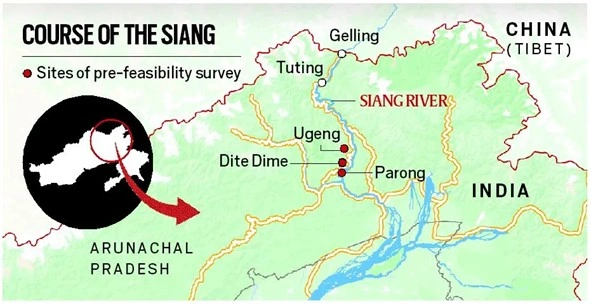
About Upper Siang Multipurpose Storage Project:
- Description:
- The Upper Siang project proposes an 11,000 MW hydropower facility on the Siang River in Arunachal Pradesh.
- Originating near Mount Kailash in Tibet (Tsangpo), the river flows over 1,000 km eastward, entering Arunachal Pradesh as the Siang and later becoming the Brahmaputra in Assam.
- Initially planned as two separate projects, it was consolidated into a single large-scale project in 2017, to be developed by the National Hydroelectric Power Corporation (NHPC) featuring a 300-metre high dam.
- Strategic Importance:
- Strategic Purpose:
- The project is seen as a strategic response to China's ambitious hydropower projects on the Tsangpo, notably a proposed 60,000 MW 'super dam' in Tibet's Medog county.
- This mega-dam, with a capacity nearly three times that of China's Three Gorges Dam, aims to redirect water resources to northern China.
- Strategic Purpose:
- The Upper Siang project proposes an 11,000 MW hydropower facility on the Siang River in Arunachal Pradesh.
Environmental and Social Concerns:
- Concerns Raised:
- Activists and anti-dam organisations have highlighted significant environmental and social concerns in their protests.
- They emphasise the potential threat to delicate ecosystems, wildlife habitats, and biodiversity in Arunachal Pradesh, a region already heavily impacted by existing dam projects.
- Of particular concern is the potential displacement of communities, including over 300 villages of the Adi tribe, including the district headquarters of Yingkiong.
- Legislative Issues:
- Activists criticise the project's classification as a national interest endeavour under the Forest (Conservation) Amendment Act, which exempts strategic projects within 100 km of India's borders from specific clearance requirements.
Forest (Conservation) Amendment Act, 2023:
- About:
- Land Under the Purview of the Act
- Defines two categories of land:
- Land declared as forest under the Indian Forest Act or any other law, or notified as a forest after 25th October 1980.
- Land converted from forest to non-forest use before 12th December 1996.
- Exemptions from the Act:
- Allows exemptions for:
- Up to 0.10 hectares of forest land for connectivity purposes along roads and railways.
- Up to 10 hectares for security-related infrastructure.
- Up to 5 hectares in Left Wing Extremism Affected Districts for public utility projects.
- Additionally, strategic projects within 100 km of international borders, LAC, and LoC are also exempted.
- Permitted Activities in Forest Land:
- Includes conservation, management, and development efforts.
- Activities like zoos, ecotourism facilities, silvicultural operations, and specified surveys are exempted from non-forest purposes.
- Assignment/Leasing of Forest Land:
- Extends the requirement for obtaining prior approval from the central government for the assignment of forest land to any entity, broadening the scope beyond private entities.
- Grants the central government authority to stipulate the terms and conditions governing such assignments.
- Allows exemptions for:
- Defines two categories of land:
- Land Under the Purview of the Act

|
UPSC Civil Services Examination Previous Year Questions (PYQs) Prelims Q:1 The Brahmaputra, Irrawaddy and Mekong rivers originate in Tibet and flow it through narrow and parallel mountain ranges in their upper reaches. Of these rivers, Brahmaputra makes a “U” turn in its course to flow into India. This “U” turn is due to: (a) Uplift of folded Himalayan series (b) Syntaxial bending of geologically young Himalayas (c) Geo-tectonic disturbance in the tertiary folded mountain chains (d) Both (A) and (B) above Answer: B
Mains: Q:1 Bring out the causes for more frequent landslides in the Himalayas than in Western Ghats. (2013) Q:2 Describe the various causes and the effects of landslides. Mention the important components of the National Landslide Risk Management Strategy. (2021) |
Source: IE
SDG India Index 2023-24- NITI Aayog
Why in the News?
- The overall SDG score for the country is 71 for 2023-24, a significant improvement from 66 in 2020-21 and 57 in 2018 (Baseline report).
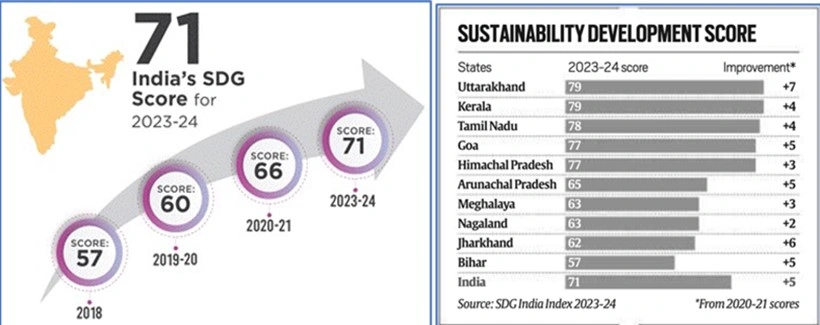
About SDG India Index:
- Developed by NITI Aayog to measure the progress of India and its states/UTs towards achieving the Sustainable Development Goals (SDGs).
- Tracks progress on 113 indicators aligned with the National Indicator Framework of the Ministry of Statistics and Programme Implementation (MoSPI).
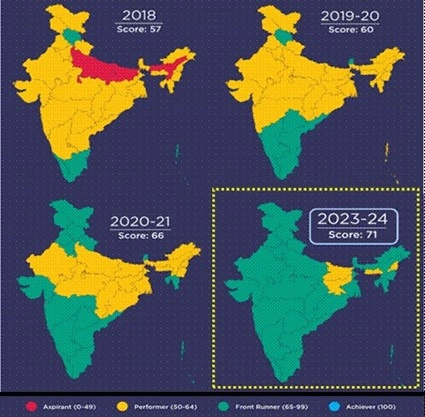
Key Highlights from the Fourth Edition of the SDG India Index:
- Top Performers:
- Uttarakhand and Kerala: Secured top spots with a score of 79 out of 100, showcasing strong performance in poverty eradication, health, education, and environmental sustainability.
- National Improvement:
- India's Overall SDG Score: Improved from 66 points in 2020-21 to 71 points in 2023-24, indicating significant progress in achieving the SDGs nationwide, reflecting efforts in poverty reduction, economic growth, and environmental conservation.
- State-wise Variations:
- Bihar: Ranked lowest with 57 points, indicating areas needing more attention and development.
- Notable Improvements: States like Punjab, Manipur, West Bengal, and Assam showed notable improvements, with Punjab leading with an increase of 8 points to reach 76 points.
- Goal-specific Insights:
- Highest Increases: Goals such as “No Poverty,” “Decent Work and Economic Growth,” and “Life on Land” saw the highest increases in scores, reflecting advancements in income equality, employment opportunities, and biodiversity conservation efforts.
- Challenges: Gender Equality received the lowest score at 49 points, highlighting persistent challenges in achieving parity in workforce participation, education access, and political representation.
- Priority Issues: Addressing issues related to hunger and nutrition remains a priority, with the “Zero Hunger” goal scoring 52 points, emphasising the need for nutritious food access and combating malnutrition.
Key interventions facilitating SDG achievements :
- Over 4 crore houses under the PM Awas Yojana (PMAY),
- 11 crore Toilets & 2.23 lakh Community Sanitary Complexes in rural areas
- 10 crore LPG connections under PM Ujjwala Yojana,
- Tap water connections in over 14.9 crore households under Jal Jeevan Mission
- Over 30 crore beneficiaries under Ayushman Bharat -Pradhan Mantri Jan Arogya Yojana
- Coverage of over 80 crore people under the National Food Security Act (NFSA)
- Access to 150,000 Ayushman Arogya Mandir which offer primary medical care and provide affordable generic medicines
- Direct Benefit Transfer (DBT) of ₹34 lakh crore made through PM-Jan Dhan accounts.
- The Skill India Mission has led to over 1.4 crore youth being trained and upskilled and has reskilled 54 lakh youth
- PM Mudra Yojana sanctioned 43 crore loans aggregating to ₹22.5 lakh crore for entrepreneurial aspirations of the youth besides Funds of Funds
- Start Up India and Start Up Guarantee schemes assisting the youth
- The Saubhagya scheme for access to electricity
- Emphasis on renewable energy resulted in an increase in solar power capacity from 2.82 GW to 73.32 GW in the past decade.
- Between 2017 and 2023, India has added around 100 GW of installed electric capacity, of which around 80% is attributed to non-fossil fuel-based resources.
- Improvement in digital infrastructure with reduced internet data costs by 97% which has in turn positively affected and fostered financial inclusion
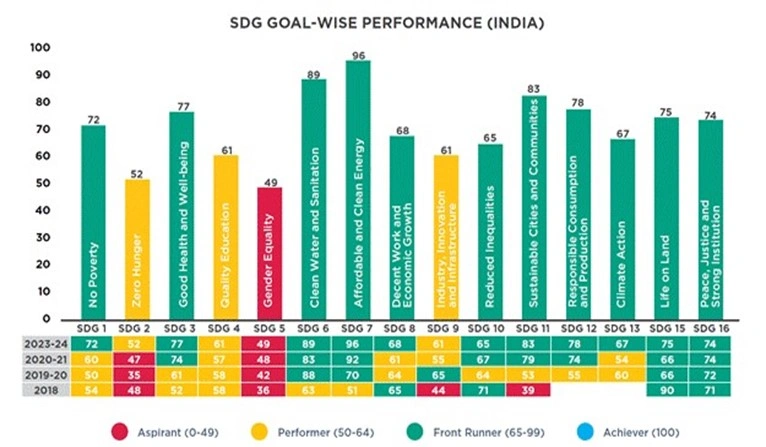
How Did States and UTs Perform?
- Score Ranges:
- States: Scores range from 57 to 79.
- UTs: Scores range from 65 to 77, showing an improvement compared to the 2020-21 scores (52 to 75 for States and 62 to 79 for UTs).
- Front Runner Category:
- Increase in Front Runners: Significant increase in the number of States and UTs achieving Front Runner status. In the latest edition, 32 States/UTs scored between 65 and 99, up from 22 in the previous edition.
- New Entries: 10 new States and UTs entered the Front Runner category, including Arunachal Pradesh, Assam, Chhattisgarh, Madhya Pradesh, Manipur, Odisha, Rajasthan, Uttar Pradesh, West Bengal, and Dadra and Nagar Haveli and Daman and Diu.
- Score Improvements:
- Composite Score Improvements: Across all States and UTs, there has been improvement in composite scores ranging from 1 to 8 points since the 2020-21 edition.
- Leading Improvements: Assam, Manipur, Punjab, West Bengal, and Jammu and Kashmir showed an increase of 8 points.
- Methodology:
- Data Compilation: Involves compiling raw data for indicators, setting 2030 targets, normalising data to a 0-100 score, and calculating Goal scores as means of relevant indicators.
- Composite Score: Represents an average of all Goal scores, excluding Goal 14 focused solely on coastal States.
Way Forward:
- Targeted Interventions for Lagging States:
- Implement customised, data-driven interventions in States with lower scores, such as Bihar, to address specific challenges in poverty, health, and education.
- Enhance Focus on Gender Equality and Nutrition:
- Strengthen policies and programs aimed at improving gender equality and combating malnutrition, particularly by increasing female workforce participation and ensuring access to nutritious food.
Source: IE
The PDS impact on household expenditure
Why in the News?
- The Household Consumption Expenditure Survey Data provides an opportunity to analyse the effects of social transfers.

About Public Distribution System (PDS):
- Objective:
- The Public Distribution System (PDS) aims to ensure food security by providing subsidised foodgrains to economically vulnerable sections of society.
- National Food Security Act (NFSA), 2013:
- Coverage: Up to 75% of the rural population and 50% of the urban population are eligible for subsidised foodgrains.
- Distribution: Foodgrains procured by the Food Corporation of India (FCI) are distributed through a network of Fair Price Shops (FPS).
- Structural Mandate:
- Procurement and Distribution:
- The FCI procures food grains from farmers at Minimum Support Prices (MSP).
- These foodgrains are allocated to states and union territories and distributed to Fair Price Shops (FPS) to deliver subsidised foodgrains to eligible beneficiaries.
- Identification and Subsidy:
- Beneficiaries are identified based on the Socio-Economic and Caste Census (SECC) data.
- Households are classified into Priority Households and Antyodaya Anna Yojana (AAY) households.
- Under the NFSA, eligible households receive rice at ₹3 per kg, wheat at ₹2 per kg, and coarse grains at ₹1 per kg.
- Procurement and Distribution:
Observations Made by the HCES: 2022-23 Report:
- Coverage Insights:
- The Household Consumption Expenditure Survey (HCES) 2022-23 provides insights into the coverage of social welfare programs, including the Public Distribution System (PDS).
- Discrepancies:
- The survey highlights discrepancies between administrative data and survey estimates due to inclusion and exclusion errors.
- It offers detailed characteristics of households benefiting from these programs.
Imputation of Values for Food and Non-Food Items:
- Definition:
- Imputation of values for food and non-food items refers to assigning a monetary value to items received by households for free or at a subsidised rate through social welfare programs like the PDS in India.
- Purpose:
- Imputation estimates the total consumption expenditure of households more accurately by accounting for goods received without direct payment.
- Methodology:
- The National Sample Survey Office (NSSO) and other agencies use statistical methods to assign a value to these items.
- Modal (most common) or percentile prices of items received, varying by state and rural/urban classification, are used.
- Types of Items Imputed:
- Primarily includes foodgrains from PDS but can extend to other essential commodities provided through government schemes.
- Data Sources:
- Data comes from surveys like the HCES, where households report receiving these items.
- NSSO surveys provide guidelines on deriving and applying imputation values.
- Impact on Analysis:
- Imputing values allows accurate computation of metrics like Monthly Per Capita Consumption Expenditure (MPCE), reflecting true economic status and welfare impact.
Implications for Poverty:
- Economic Relief:
- PDS reduces the financial burden on poorer households by providing highly subsidised foodgrains, allowing allocation of resources to other essential needs.
- Enhanced Measurement:
- Imputing the value of free or subsidised items provides a comprehensive assessment of household consumption and a more accurate reflection of economic well-being.
- Policy Insights:
- Understanding the impact of imputed values helps in effectively targeting social welfare programs.
- Diversification of Diet:
- Access to subsidised food grains allows households to free up resources to purchase a diverse range of nutrient and protein-rich foods.
Way Forward:
- Enhancing Efficiency and Targeting:
- Improve identification and targeting of beneficiaries through updated and accurate data collection methods.
- Continuous validation and updating of SECC data to reduce inclusion and exclusion errors.
- Promoting Nutritional Security:
- Expand the scope of subsidised items beyond basic grains to include more nutritious food options like pulses, edible oils, and fruits.
|
UPSC Civil Services Examination, Previous Year Questions (PYQs) Mains Q:1 What are the major challenges of the Public Distribution System (PDS) in India? How can it be made effective and transparent? (2022) Q:2 Food Security Bill is expected to eliminate hunger and malnutrition in India. Critically discuss various apprehensions in its effective implementation along with the concerns it has generated in WTO. (2013) |
Source : TH
National Gopal Ratna Award, 2024
Why in the News?
- Recently, The Department of Animal Husbandry and Dairying has conferred the National Gopal Ratna Award (NGRA) 2024.
- Annually awarded on National Milk Day, celebrated on 26th November.
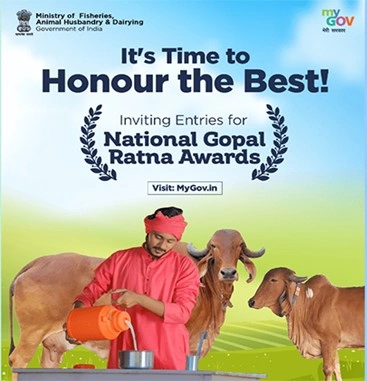
What is the National Gopal Ratna Award (NGRA)?
- Initiative: Part of the Rashtriya Gokul Mission to promote indigenous bovine breeds crucial for India's dairy sector sustainability.
- Objective: Encourages conservation and development of indigenous bovine breeds.
Categories:
- Best Dairy farmer rearing indigenous cattle/buffalo breeds.
- Best Dairy Cooperative Society (DCS)/ Milk Producer Company (MPC)/ Dairy Farmer Producer Organization (FPO).
- Best Artificial Insemination Technician (AIT).
Other Aspects:
- Special Recognition: Includes a category for North Eastern Region (NER) states.
- Nomination and Recognition: Nominations submitted online through the National Award portal.
Award Details:
- Cash Prizes:
- 5,00,000/- (1st rank)
- 3,00,000/- (2nd rank)
- 2,00,000/- (3rd rank)
- 2,00,000/- (Special Award for NER)
- Best AIT category: Certificate of merit and a memento.
Rashtriya Gokul Mission:About:
Nodal Ministry:
Objectives:
|
|
UPSC Civil Services Examination Previous Year Questions (PYQs) Mains: Q:1 Livestock rearing has a big potential for providing non-farm employment and income in rural areas. Discuss suggesting suitable measures to promote this sector in India.(2015) |
Source: PIB
Salvinia molesta
Why in the News ?
- Recently, an exotic beetle was released into a large reservoir in Betul district, successfully eradicating the invasive weed species Salvinia molesta within just 18 months.
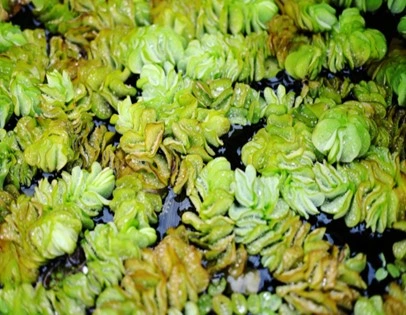
- An exotic beetle released into a vast (2,800-acre) reservoir in Betul district has successfully eradicated an invasive weed species, Salvinia molesta, within 18 months.
About Salvinia molesta:
- Description: Highly detrimental aquatic fern, also known as "Water Fern," originating from South-Eastern Brazil.
- Habitat: Prefers tropical, subtropical, or warm temperate regions and thrives in still or slow-moving water bodies like ditches, ponds, lakes, slow rivers, and canals.
- Introduction to India: First identified in 2018 and rapidly carpeted the reservoirs by 2019, locally referred to as "Chinese Jhalaar."
- Environmental Impact: Forms dense mats that hinder water flow, reduce light penetration, and deplete oxygen levels, adversely affecting aquatic ecosystems.
- Other Uses: Introduced as an ornamental plant and used as mulch in agriculture, particularly in dry areas near water bodies where it can grow.
Source: DTE
Bacteriophage
Why in the news ?
- Recently, researchers have innovated a straightforward method for storing, identifying, and distributing bacteriophages, enhancing accessibility for patients in need.
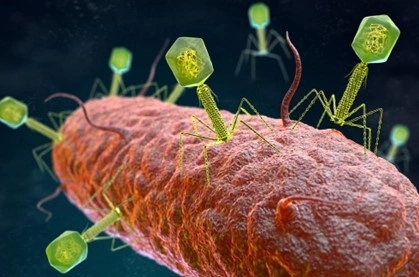
What is a Bacteriophage?
- Definition: A bacteriophage is a type of virus that specifically infects bacteria.
- Name Meaning: "Bacteriophage" translates to "bacteria eater," reflecting their role in destroying host cells.
- Abundance: They are the most prevalent biological entities in nature.
- Distribution: Found ubiquitously where bacteria exist: in soil, deep within the earth’s crust, within plants, animals, and oceans.
- Variety: Thousands of phage varieties exist, each targeting specific types of bacteria or archaea.
- Structure: Composed of a nucleic acid core (DNA or RNA) surrounded by a protein coat.
Infection Process:
- Attachment and Invasion: Bacteriophages attach to susceptible bacteria and inject their genetic material into the host cell.
- Manipulation: They reprogram the bacterium's machinery to produce viral components instead of bacterial ones.
- Replication and Release: New bacteriophages assemble within the host cell and burst out (lyse) to infect other bacteria.
- Genetic Exchange: Some phages can incorporate bacterial DNA during infection and transfer it to new host cells, a process known as transduction.
Applications:
- Combating Antibiotic Resistance: Phages are natural agents capable of targeting antibiotic-resistant bacteria.
- Phage Therapy: Promising for treating infections where antibiotics are ineffective, contributing to antimicrobial resistance (AMR) solutions.
Recent Developments:
- Researchers have simplified storage, identification, and accessibility of phages, enhancing their potential for therapeutic applications.
Source: PH
MeDevIS Platform
Why in the news ?
- Recently, the World Health Organization (WHO) has introduced an online platform called MeDevIS.

About MeDevIS Platform:
- Introduction: Recently launched by the World Health Organization (WHO), MeDevIS is an online platform.
- Purpose: It serves as the first global open-access clearinghouse for medical device information.
- Objective: Designed to assist governments, regulators, and users in decision-making regarding the selection, procurement, and utilisation of medical devices for diagnostics, testing, and treatment.
- Improvement: Replaces traditional paper-based literature searches across multiple publications, simplifying the complex process caused by non-standard device names.
- Standardisation: MeDevIS integrates two international naming systems:
- European Medical Device Nomenclature (EMDN): Primarily used in Europe for registration in the European database.
- Global Medical Device Nomenclature (GMDN): Utilised by regulatory agencies in Australia, Canada, the UK, USA, and other member states.
- Functionality: These systems provide codes and definitions universally applicable for regulatory approvals, procurement, inventory management in healthcare facilities, tracking, and pricing.
- Impact: Facilitates national policymakers in developing or updating procurement lists for health technologies, advancing towards universal health coverage.
- Support: Assists health agencies in formulating health insurance and reimbursement policies for patients
Source: WHO
Demographic Disaster to Demographic Dividend
Context:
- India reflects on its demographic evolution and the challenges and disparities faced since 1989.
- In 1968, American biologist Paul Ralph Ehrlich published "The Population Bomb," raising serious concerns about India's ability to feed its growing population.
- The Green Revolution in the late 1960s and early 1970s significantly changed the scenario by dramatically increasing food production through the introduction of high-yielding crop varieties, improved irrigation, and the use of fertilisers and pesticides.
What is meant by Demographic Dividend?
Definition:
- The United Nations Population Fund (UNFPA) defines the demographic dividend as "the economic growth potential that can result from shifts in a population’s age structure, mainly when the share of the working-age population (15 to 64) is larger than the non-working-age share of the population (14 and younger, and 65 and older)."
India's Demographic Dividend:
- Window of Opportunity: India entered the demographic dividend opportunity window in 2005-06 and will remain there till 2055-56.
- Young Population: Approximately 68% of the population falls between the ages of 15 and 64, and 26% falls within the 10-24 age group, making India one of the youngest countries globally.
- Median Age: India has a relatively young population with a median age of 28.4 years.
- Working-Age Population by 2030: By 2030, India will have 1.04 billion working-age persons.
- Dependency Ratio: India's dependency ratio is expected to be the lowest in its history by 2030 at 31.2%.
- Global Workforce Contribution: India is projected to contribute about 24.3% of the incremental global workforce over the next decade, making it the largest provider of human resources in the world.
Implications:
- Economic Growth: A larger working-age population can potentially lead to higher economic growth if adequately educated, skilled, and employed.
- Human Resources: India’s significant contribution to the global workforce positions it as a crucial player in international markets.
- Policy Focus: To fully capitalise on this demographic dividend, India needs to focus on:
- Education and Skill Development: Enhancing the quality and reach of education and vocational training.
- Healthcare: Ensuring access to quality healthcare to maintain a healthy workforce.
- Employment Opportunities: Creating sufficient job opportunities to absorb the growing workforce.
- Gender Equality: Promoting equal participation of women in the workforce.
What are the Factors that Can Lead to Demographic Disaster?
- High Unemployment Rate:
- Labor Force Growth: An increase in population leads to a corresponding rise in the labour force, resulting in a significant portion of the population experiencing unemployment.
- India Employment Report 2024: India's working population increased from 61% in 2011 to 64% in 2021 and is projected to reach 65% in 2036.
- However, the percentage of youth involved in economic activities declined to 37% in 2022.
- Ageing Population:
- Rapid Growth: India's elderly population is growing rapidly, with a decadal growth rate of 41%.
- India Ageing Report 2023 (UNFPA): By 2050, over 20% of India's population will be elderly, posing challenges related to healthcare, social, and financial security.
- Resource Scarcity:
- Water Stress: Rapid population growth negatively affects resource usage and access.
- Examples: Cities like Delhi and Bangalore and the state of Rajasthan face severe water stress.
- Central Water Commission Survey: India's per capita water availability has dropped from 1,816 cubic metres in 2001 to approximately 1,486 cubic metres in 2024, indicating increasing water stress.
- Low Living Standards:
- Public Expenditures: Rapid population growth makes it difficult for low-income and lower-middle-income countries to afford increases in public expenditures on social sectors, negatively impacting the quality of life.
- Vicious Cycle of Poverty: Limits access to education, healthcare, and job opportunities, undermining the demographic dividend.
- High Fertility Rates and Social Inequality: Increase economic burdens, while poor infrastructure and economic instability stifle growth.
- Water Stress: Rapid population growth negatively affects resource usage and access.
- Rapid Growth: India's elderly population is growing rapidly, with a decadal growth rate of 41%.
- India Employment Report 2024: India's working population increased from 61% in 2011 to 64% in 2021 and is projected to reach 65% in 2036.
- Labor Force Growth: An increase in population leads to a corresponding rise in the labour force, resulting in a significant portion of the population experiencing unemployment.
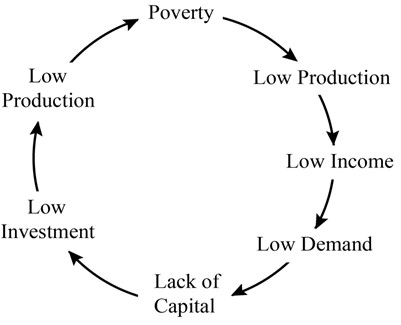
-
-
-
-
- Unplanned Urbanisation:
- Issues: Overburdened infrastructure, traffic congestion, pollution, slum growth, housing challenges, and environmental degradation.
- Urban Population Growth: India's urban population is expected to grow from 410 million in 2014 to 814 million by 2050.
- The country is projected to add four new megacities by 2030, potentially exacerbating unplanned urbanisation and related issues.
- Urban Population Growth: India's urban population is expected to grow from 410 million in 2014 to 814 million by 2050.
- Issues: Overburdened infrastructure, traffic congestion, pollution, slum growth, housing challenges, and environmental degradation.
- Unplanned Urbanisation:
-
-
-
What Should India Further Do to Reap its Demographic Dividend?
● Education and Skills Development:
- Enhance Education Quality and Accessibility:
- Implement policies that improve the quality of education, especially in rural and marginalised areas.
- Ensure universal access to primary and secondary education with a focus on inclusivity.
- Promote Vocational Training:
- Align vocational training programs with industry demands.
- Establish more skill development centres, especially in underserved regions.
- Invest in Digital Literacy:
- Integrate digital literacy and technology skills into the education curriculum.
- Provide access to digital tools and internet connectivity to students and workers.
● Employment Generation
- Conducive Business Environment:
- Simplify regulatory frameworks to attract investments.
- Provide tax incentives and support to small and medium enterprises (SMEs).
- Encourage Entrepreneurship:
- Offer financial support, mentorship, and incubation services to startups.
- Develop policies that encourage innovation and entrepreneurship among youth.
- Support for Gig and Platform Workers:
- Develop social security schemes for gig and platform workers.
- Recognize and formalise the gig economy to ensure worker protections.
● Healthcare and Well-being
- Strengthen Healthcare Infrastructure:
- Increase investment in healthcare facilities, particularly in rural areas.
- Improve the quality and reach of primary healthcare services.
- Focus on Preventive Healthcare:
- Implement widespread nutrition programs to address malnutrition.
- Promote vaccination and health awareness campaigns.
- Mental Health Support:
- Integrate mental health services into primary healthcare.
- Raise awareness and reduce stigma associated with mental health issues.
● Inclusive Growth and Gender Equality
- Promote Gender Equality:
- Implement policies that ensure equal access to education and employment for women.
- Provide incentives for companies to hire and promote women.
- Enhance Social Cohesion:
- Support community-based programs that reduce social inequalities.
- Encourage initiatives that foster social inclusion and diversity.
- Increase Women's Workforce Participation:
- Create childcare support systems to enable women to join the workforce.
- Enforce laws against workplace discrimination and harassment.
● Infrastructure Development
- Robust Infrastructure Investments:
- Prioritise development in transport, energy, and digital infrastructure.
- Focus on sustainable and environmentally friendly projects.
- Urban Planning Improvements:
- Develop comprehensive urban planning strategies to manage migration and urbanisation.
- Invest in affordable housing and public transportation.
- Sustainable Development:
- Ensure that infrastructure projects support long-term economic growth and environmental sustainability.
● Shifting from Agriculture to Formal Sector
- Transition Workforce to Formal Employment:
- Create incentives for businesses to hire from the informal sector.
- Provide training and reskilling programs for workers transitioning from agriculture to formal employment.
- Address Disguised Employment:
- Encourage mechanisation and modern farming techniques to reduce labour dependency in agriculture.
- Promote sectors like manufacturing and services that can absorb the labour force.
● Policy and Governance
- Comprehensive Policy Formulation:
- Develop policies that specifically address the demographic dividend.
- Ensure these policies are data-driven and evidence-based.
- Strengthen Governance Mechanisms:
- Improve transparency and accountability in implementing initiatives.
- Foster public-private partnerships to leverage resources and expertise.
- Collaboration and Systemic Solutions:
- Encourage collaboration between government, private sector, and civil society.
- Promote initiatives that address systemic challenges and drive inclusive growth.
|
UPSC Civil Services Examination, Previous Year Questions (PYQs) Prelims: Q:1 To obtain full benefits of demographic dividend, what should India do? (2013) (a) Promoting skill development (b) Introducing more social security schemes (c) Reducing infant mortality rate (d) Privatisation of higher education Ans: (a)
Q:2 Consider the following specific stages of demographic transition associated with economic development: (2012)
Select the correct order of the above stages using the codes given below: (a) 1, 2, 3 (b) 2, 1, 3 (c) 2, 3, 1 (d) 3, 2, 1 Ans: (c)
Mains: Q:1 “Demographic Dividend in India will remain only theoretical unless our manpower becomes more educated, aware, skilled and creative.” What measures have been taken by the government to enhance the capacity of our population to be more productive and employable? (2016) Q:2“While we flout India’s demographic dividend, we ignore the dropping rates of employability.” What are we missing while doing so? Where will the jobs that India desperately needs come from? Explain. ? (2014) |
Source: TH
Share the article
Get Latest Updates on Offers, Event dates, and free Mentorship sessions.

Get in touch with our Expert Academic Counsellors 👋
FAQs
UPSC Daily Current Affairs focuses on learning current events on a daily basis. An aspirant needs to study regular and updated information about current events, news, and relevant topics that are important for UPSC aspirants. It covers national and international affairs, government policies, socio-economic issues, science and technology advancements, and more.
UPSC Daily Current Affairs provides aspirants with a concise and comprehensive overview of the latest happenings and developments across various fields. It helps aspirants stay updated with current affairs and provides them with valuable insights and analysis, which are essential for answering questions in the UPSC examinations. It enhances their knowledge, analytical skills, and ability to connect current affairs with the UPSC syllabus.
UPSC Daily Current Affairs covers a wide range of topics, including politics, economics, science and technology, environment, social issues, governance, international relations, and more. It offers news summaries, in-depth analyses, editorials, opinion pieces, and relevant study materials. It also provides practice questions and quizzes to help aspirants test their understanding of current affairs.
Edukemy's UPSC Daily Current Affairs can be accessed through:
- UPSC Daily Current Affairs can be accessed through Current Affairs tab at the top of the Main Page of Edukemy.
- Edukemy Mobile app: The Daily Current Affairs can also be access through Edukemy Mobile App.
- Social media: Follow Edukemy’s official social media accounts or pages that provide UPSC Daily Current Affairs updates, including Facebook, Twitter, or Telegram channels.

